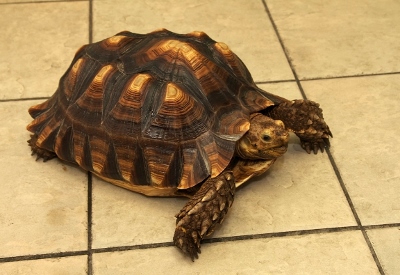
The larger-than-life sulcata tortoise is now lumbering out of the spotlight as our Animal of the Month now that May is just about over. We tweeted all month long @ExoticPetVets about the sulcata tortoise and we hope you enjoyed the fun and fascinating facts we shared about our featured creature. In case you missed any of our tweets, here’s a summary for your reference. Did you know?:
- The Sulcata tortoise (Geochelone (Centrochelys) sulcata) is endemic to the south edge of the Sahara across north Africa.
- Wild sulcata tortoises roam the Sahel – a region where the Sahara desert ends and transitions to the Sudanian Savanna.
- The sulcata part of the sulcata tortoise’s name comes from the Latin sulcus, which means furrow or groove.
- Sulcata tortoises have deep grooves in their upper shell (carapace).
- Sulcata tortoises are also known as African spurred tortoises because of the prominent spurs they have on their back ends.
- The Sulcata tortoise is the largest mainland tortoise species and third largest tortoise in the world.
- Only the island species of Galápagos and Aldabra tortoises are bigger than the sulcata tortoise.
- Baby sulcata tortoises are only about 2 – 3 inches (5 – 7 cms) long when they’re born, but they grow quickly.
- Adult sulcata tortoises can grow to be about 33 inches (83 cms), or nearly 3 feet in length, and weigh more than 200 lbs.
- A behaviour unique to sulcata tortoises is digging burrows, at which they’re quite proficient.
- In the wild, sulcata tortoises will tunnel 10 feet or more underground as they dig their burrows.
- Sulcata tortoises shelter from the daytime African heat in their burrows, which also expose them to ground moisture.
- Sulcata tortoises have impermeable skin to guard against fluid loss.
- Sulcata tortoises are crepuscular reptiles, meaning they are most active during dawn and dusk.
- Did you know that sulcata tortoises can live between 50-150 years?
- As we celebrate the sulcata tortoise as our Animal Of The Month, we should note that May 23rd is World Turtle Day.
- Sulcata tortoises have become popular as pets because they’re smart, inquisitive and have a friendly disposition.
- Because of their large size and care requirements many people find sulcata tortoises unmanageable as pets.
- Due to their long life-span, properly cared for captive sulcata tortoises will almost certainly outlive their caregivers.
- Like all turtles and tortoises, sulcata tortoises can feel pressure and pain through their shells.
- Due to Salmonella bacterium concerns, always wash your hands after handling any turtle or tortoise.

